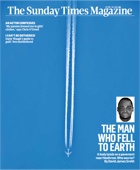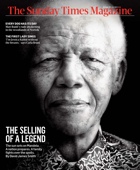The critics on Young Mandela
Daily Mail – Peter Lewis
This book may come as a shock to those who are used to regarding the world’s most revered elder statesman as a saint. Al though he has wri tten hi s own autobiography, Mandela has never given away much about his private life. David James Smith had no help from him either, but he had the support of the Nelson Mandela Foundation in presenting the hero as a human being with human faults.
This is in no sense a hatchet job. But the consequences of Mandela’s life of struggle and rebellion costs not just him, but everyone close to him dear.
The first problem the author had is what to call him. When he was born in 1918, his father called him Rolihlahla — equivalent roughly to ‘troublemaker’.
His father was related to the chiefs of the Thembu Tribe, which occupies the Transkei district of Eastern Cape province. He had four wives and he died when Mandela was nine. He was put in the care of the acting chief and brought up in the tribal Great House.
His English teacher at the local Methodist mission school couldn’t cope with African names, so it was she who called him Nelson. When he underwent the circumcision ritual that symbolised manhood, he was given the tribal name of Dalibunga. But family and close friends refer to him as Madiba.
His education was chequered. He went to Fort Beaufort, a little slice of England run by a Dr Wellington, descended from the Duke. Next came Fort Hare, the black Oxbridge, whose alumni include Robert Mugabe and Kenneth Kaunda. But he was suspended for refusing to serve on the student council, which he and his friends were boycotting.
Hoping to be the first black barrister in Johannesburg, he read part-time for a law degree at Witwatersrand University, but failed the finals three times. He believed he was failed because he was black. So he got a diploma and set up as an attorney with his friend Oliver Tambo. Despite his lack of means, he contrived to dress superbly in hand-tailored suits (for which the tailor may not have charged him).
HIS endless queue of clients were often too poor to pay fees — so he waived them. He was tall, handsome and thin — thanks to the running and boxing which he took up at university. He was a born charmer with natural charisma. Inevitably women fell at his feet.
The one he married when he was 26, Evelyn, was almost written out of his story in later years. They had two sons and two daughters and he acquired his first home in Orlando East, a district of Soweto. He was ‘mightily proud’ of it although, like every other home in the area, it had a tin roof, a bucket toilet at the back and no electric light. Evelyn began to complain of his f ri endshi ps wi th other pretty women including Ruth, his secretary, whom he sometimes brought home after work and who would follow him into the bedroom, possibly not to take dictation. There were other lady friends from the African National Congress, to whom he devoted nearl y al l his leisure.
The marriage had worn out well before the dazzling beauty Winnie Madikizela came on the scene and divorce had been started on both sides. Eventually Evelyn walked out. She alleged that he had assaulted her, but later withdrew her petition.
In 1958 the divorce became final and he married Winnie, who came to live at the Orlando East house which is now a museum.
Each was the love of each other’s life — or so they said. They had two daughters, but very little time to spend together. Within a few months of his second daughter’s birth, he went underground in hiding and disguise as a wanted man.
Winnie managed to have occasional clandestine meetings with him but, as marriages go, it was extremely short and fraught. She had years of financial struggle to bring up their children. It has to be remembered that their lives were lived in the harshest years of Apartheid, under the porcine racial prejudice of the government.
NATIVE Africans — Kaffirs — were regarded only as labourers or servants without rights, who had to call white men Baas. Whites would push them off the pavement if they hadn’t stepped off it already.
Macmillan’s Wind of Change speech was a stern rebuke to the South African Parliament given that the country was after all a member of the Commonwealth. Their reaction was to declare a republic and leave the Commonwealth.
The Sharpeville Massacre followed hard upon Macmillan’s visit. The excuse for it was self-defence, but the 69 unarmed demonstrators killed, including women and children, were shot in the back.
It is little wonder that men like Mandela decided there was no alternative to armed struggle.
He instigated the military wing of the ANC and became its commander in chief, although he had never fired a shot. He organised military training and went to Ethiopia to be taught it himself. He became, in short, a terrorist. Although many ANC leaders had by then gone into exile for safety, he came back to lead the struggle and inevitably to be arrested and put on trial for his life.
He turned the trial into a propaganda triumph, looking magnificent in the tribal robes of a Thembu chief made of jackal skins. He defended himself with a great ‘I am prepared to die’ speech. In place of execution, he faced living death, 27 years of it, on Robben Island.
His release and ultimate triumph are perhaps all that many people know about him nowadays. This probing but sympathetic examination shows how hard it was for his wives, children and even grandchildren to bear. Both his sons met premature deaths. And there is still a legacy of suspicion between the descendants of his two families, although it has been partly defused by the efforts of his third wife, Graca Machel.
Mandela emerges from these recollections rather surprisingly as a traditional African patriarch, an autocrat in the home, a one-time lady-killer who did not show affection because to show feeling would be to show weakness.
He has since expressed his regret at the neglect his families had to suffer. He had to be a man of iron to achieve what he achieved and, at that time, he certainly was.
NEWS AND EVENTS
Latest Articles
On the cover of The Sunday Times Magazine…
Latest News
The Sleep Of Reason – The James Bulger Case by David James Smith:
Faber Finds edition with new preface, available September 15th, 2011.Young Mandela the movie – in development.
From The Guardian
Read the articleIn the Diary column of The Independent, April 13th, 2011
More on my previously unsubstantiated claim that the writer-director Peter Kosminsky, creator of The Promise, is working on a drama about Nelson Mandela. I’ve now learnt that the project is a feature film, in development with Film 4, about the young Mandela. Kosminsky is currently at work on the script and, given the complaints about the anti-Jewish bias of The Promise, it is unlikely to be a standard bland portrait of the former South African president.
Latest Review
Nelson Mandela was circumcised as a 16-year-old boy alongside a flowing river in the Eastern Cape. The ceremony was similar to those of other Bantu peoples. An elder moved through the line making ring-like cuts, and foreskins fell away. The boys could not so much as blink; it was a rite of passage that took you beyond pain. read full review
See David James Smith…
Jon Venables: What Went Wrong
BBC 1, 10.35
Thursday, April 21st, 2011





